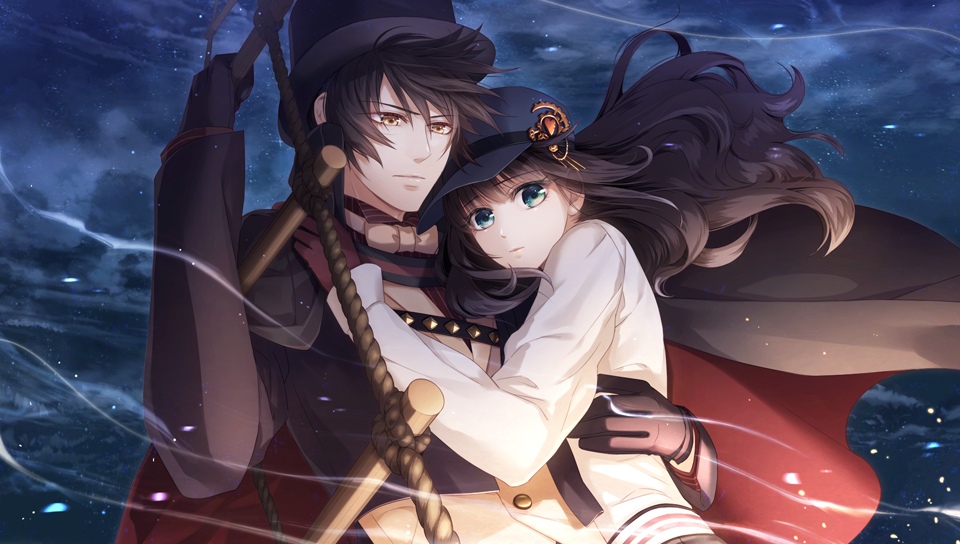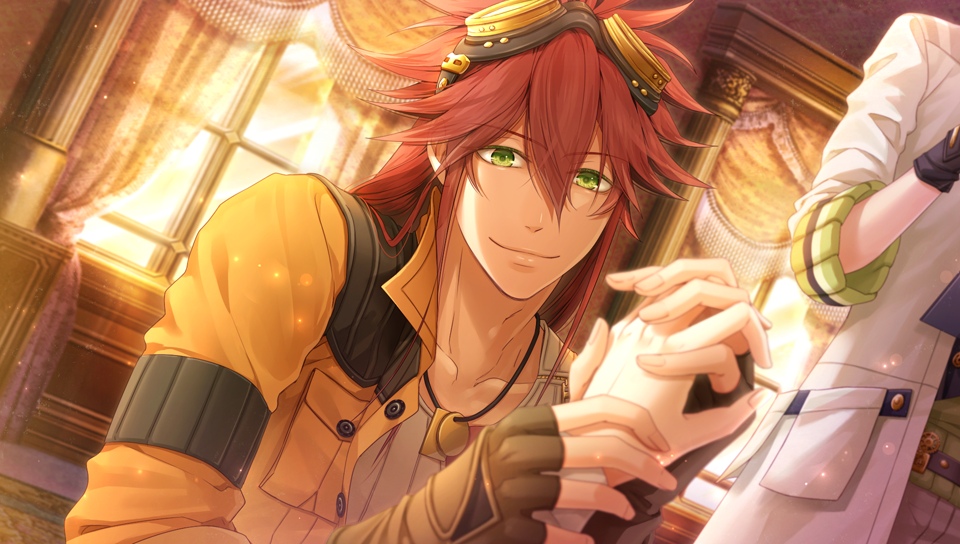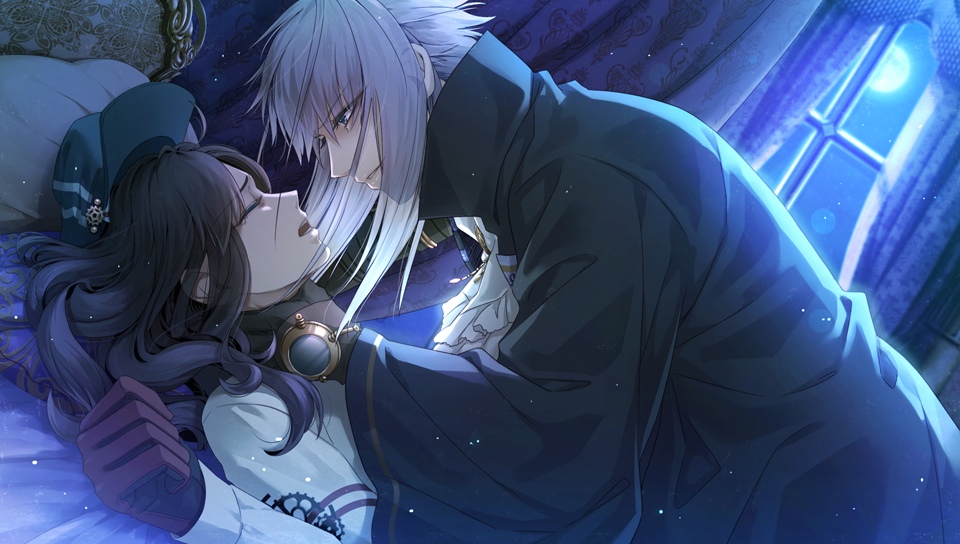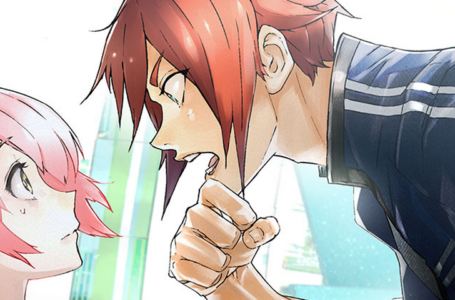Man v. Otome: on multiple endings and “true” routes in Code: Realize
Reader, I did it. I finally finished Code: Realize — and before Final Fantasy XVI came out, too, because I figured once that came out it would put pretty much any other story-based game on the back-burner until I’d rinsed it thoroughly to my satisfaction. Anyway, having now beaten Code: Realize, I feel compelled to talk generally about the concept of multiple endings, true routes and various other things that are relevant not just to otome games specifically, but which definitely apply to Code: Realize.
For the unfamiliar, Code: Realize is a multi-route otome game, in which there are five main love interests, each with their own narrative. A common route extends through the first half of the game, and is mostly identical on each playthrough, with the sole exception of a few scenes where protagonist Cardia chooses to specifically spend time with each love interest — in turn, determining which route she will end up on.

Of the five love interests, four are available from the outset, with the fifth (one Arsène Lupin) only being available once you have obtained the “good” endings for the other four. And each love interest’s route contains one “normal” ending, one “good” ending and at least one “bad” ending, with the latter typically occurring almost immediately after one of the few opportunities in which it is possible to make an “incorrect” choice.
This makes Lupin’s route the “true” route through Code: Realize, and his “good” ending the “canonical” ending, such as one exists in a game where several wildly different but equally plausible outcomes can result from the player’s choices. That said, it’s notable that the two follow-up fandiscs for Code: Realize both offer “what-if” scenarios that occur after each of the main love interests’ respective endings as well as alternative branches from the conclusion of the common route (or midway through the existing story) rather than necessarily acting as “sequels”.
Some people have mixed opinions about how this sort of thing is handled, with Code: Realize specifically often being criticised for withholding Lupin’s route until you’ve played all the others. This is bad, the theory runs, because those who are most interested in Lupin as a love interest are then forced to play through all the other characters’ stories before they’re able to settle down with their true husbando.

I can see their point, but the important thing to remember is that in visual novels it’s rare that “pick your waifu/husbando” is the sole reason for the existence of different narrative routes. In fact, in the otome sphere in particular many games actually play down the romance angle significantly in favour of each route simply focusing on a particular character and using them as a catalyst for a specific sequence of events.
This is definitely true in Code: Realize, since the routes for Victor, Impey, Van Helsing and Saint-Germain all head off in wildly different directions, each having its own distinct focus, atmosphere and themes that are explored. Between them, each of these routes introduce various concepts that are critical to the “true” conclusion of the game in Lupin’s route, and these concepts are introduced one at a time — one per love interest.
By contrast, Lupin’s route pretty much throws everything into the pot and brings it all together for an exceedingly over-the-top and dramatic conclusion to the story as a whole — and if you jumped straight into that inadvertently without having had the opportunity to learn about each of the core concepts individually beforehand, it would have been completely overwhelming.
Let’s talk the specifics of each of the routes to see how this works.

Some Code: Realize spoilers ahead.
Victor’s route, which is the first I played to completion, explores how alchemy and science are connected in the world of Code: Realize, and gives us a look at the true “purpose” behind Cardia’s existence — though not the full reality of it.
We learn that Cardia, as an artificially created homunculus rather than a human being, has the potential to become a “monster” if the Horologium gem that acts as her heart was ever to complete its transformation into the Philosopher’s Stone — a transformation which, rather inconveniently, is triggered by the pendant that her supposed brother (and recurring antagonist) Finis keeps about his person.
We also learn that Cardia’s creation was related to the creation of the deadly weapon Zicterium, which was used to devastating effect during the Vampire War, wiping out the vast majority of the vampiric population in Britain. We learn that Victor had a lot to do with this, and feels considerable regret about it — and also feels like helping to “cure” Cardia of the poison within her, along with her potential to become a weapon of mass destruction, will help him to atone for his sins.

Impey’s route, meanwhile, doesn’t have a ton to do with Cardia herself, aside from the fact that its main antagonist figure Nemo steals part of her Horologium to make use of as an energy source for his physically improbable flying fortress, the Nautilus.
Instead, Impey’s route primarily focuses on Impey’s own motivations for his work in engineering, along with his creation of a gravity-manipulating device that is the main reason the Nautilus is able to stay afloat — and why it requires so much energy.
Van Helsing’s route explores the background of the Vampire War further, with us learning how Van Helsing, along with several other individuals, was part of a project known as Hidden Strength, where humans were turned into living weapons by subjecting them to terrifying mental manipulation, causing them to feel constant despair, rage and fear.
Again, this route has relatively little to do with Cardia herself, though it is notable that the finale sequence for Van Helsing’s narrative unfolds extremely close to where the “true” finale unfolds; had things transpired in a slightly different part of St. Paul’s Cathedral, the whole “big plot” would have probably kicked off.

Saint-Germain’s route, meanwhile, introduces the Apostles of Idea, a supernatural society of immortal magicians led by a woman who is very strongly implied to be Eve of Garden of Eden fame (though now referring to herself as Omnibus). Idea, hoping to guide humanity down a path where they will eventually be forgiven for Original Sin, have taken to manipulating history before it happens, usually by murdering anyone who might fuck things up for the world.
As you might expect, Cardia, as an artificially created lifeform, is very much stepping on the toes of the Almighty, and thus much of Saint-Germain’s route concerns whether or not she has the right to “live” as an abomination in the eyes of God — and in the eyes of Idea.
Finally, Lupin’s route brings all these things together as well as revealing the complete truth behind not only Cardia’s creation, but also what on Earth “Code: Realize” actually is. We also learn what happened to Cardia’s father Isaac, the whereabouts of whom are the central mystery that acts as the catalyst for pretty much the entire common route.

Towards the conclusion of Lupin’s route, everything comes together. We see the devastating effects of Zicterium first-hand. We see how Cardia’s potential for destruction runs the risk of throwing the world into absolute chaos — and why Idea would very much like to stop that. We see how Nemo’s Nautilus — and Impey’s creation powering it — form a key part of bringing that chaos about.
It’s arguably only really the “Hidden Strength” plotline of Van Helsing’s route that doesn’t directly relate to what unfolds during the game’s “true” conclusion, though the main villain of that route does have a role to play in the grand finale.
Had someone been able to play Lupin’s route first, being thrown right into the middle of all these crazy things happening at once would have seemed somewhat ridiculous. Thus, the withholding of this route until one has experienced all the others is completely intentional from a narrative perspective — and not borne from a desire to prevent players from romancing their favourite husbandos.
In other words, the four routes that are open from the outset provide four distinct, self-contained stories in which you learn about one important thing in the game world — and one thing only. Only once you have firmly familiarised yourself with those four important concepts and/or characters are you given the opportunity to see how they are all relevant to the overall “big plot”.

This is perfectly sound narrative design. While one might question why things couldn’t have been implemented so that Cardia could take any of the potential husbandos through the trials and tribulations of this true finale, Lupin is set up pretty much from the outset of Code: Realize as “the main hero”, thus it makes sense for him to take a leading role in the grand finale. Although since all the love interests have their own role to play during the finale sequence, perhaps there could have been one last choice of who Cardia eventually ends up with.
But anyway, that’s the way it was designed — and it very much works well. Lupin’s route acts as a satisfying and intensely dramatic conclusion to the game as a whole, bringing some nice closure to Cardia’s narrative. It’s a journey and a half to get there — particularly if you take as long over the game as I did — but in many respects that just makes it all the more satisfying when you do eventually reach the final destination.
I think the important thing to remember here is the difference between a “visual novel” and a “dating sim”. When you’re playing something like Code: Realize, you’re playing a visual novel in which you are not “playing as” the main character; you are simply riding along with them in their head and occasionally making a decision on their behalf. In a dating sim, meanwhile, you are, more often than not, playing as “you”, and thus under those circumstances it doesn’t really make a ton of sense to withhold a waifu or husbando until you’ve exhausted all your other options.
And this is why it’s worth talking about these things. Otome games specifically are much more than the interactive romance novels for girls that some people assume them to be; in fact, it’s actually pretty rare for them to be that. Their narratives are worthy of in-depth analysis and exploration that goes beyond “who is best boy?” — and Code: Realize is just one of many great examples of how the genre can really shine and appeal well beyond its supposed target demographic.
Now, with that finally out of the way, the question is: which otome title should I spend three years reading next…?
Join The Discussion
Rice Digital Discord
Rice Digital Twitter
Rice Digital Facebook
Or write us a letter for the Rice Digital Friday Letters Page by clicking here!
Disclosure: Some links in this article may be affiliate links, which means we may earn a small commission if you make a purchase after clicking on them. This is at no additional cost to you and helps support Rice Digital!
- Letter from the Editor: passing the torch - June 30, 2023
- Super Woden GP 2 is looking promising - June 30, 2023
- Inti Creates is making a 32 bit-style Love Live action platformer - June 26, 2023







